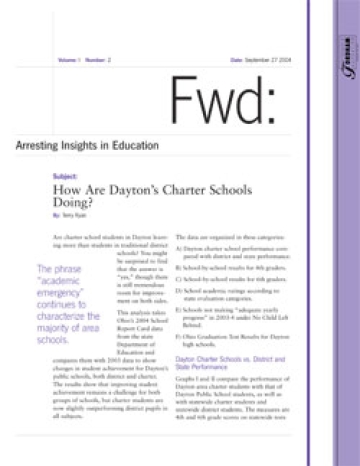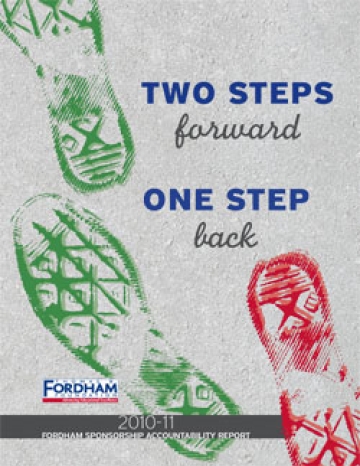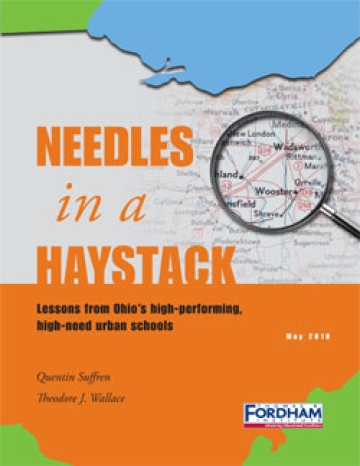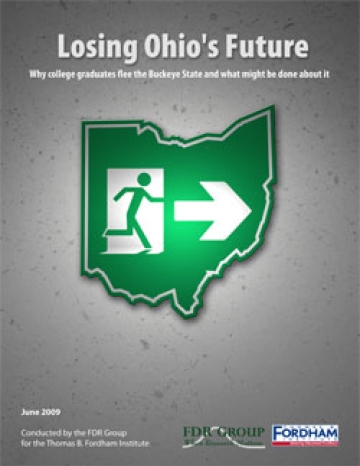What Drives Our Research
Fordham Ohio advocates for policies that advance educational excellence for all Ohio students. High-quality research and analysis—conducted in-house and by external researchers and experts—helps us advance that goal by framing key issues with sound data.

Ohio Education By the Numbers
The Thomas B. Fordham Institute is pleased to present Ohio Education By The Numbers, which is an impartial, fact-based overview of K–12 education in the Buckeye State. We hope these data will inform conversations about improving education throughout the state.

Turning around troubled schools: How Ohio can create a stronger, clearer school improvement program
As Governor Mike DeWine asserted, the state of Ohio has “a moral obligation” on behalf of students to step in when schools are falling short of academic performance standards. Under the Every Student Succeeds Act (ESSA), federal lawmakers have given states the ability to chart their own course when it comes to fixing under-performing schools. Shifting authority—and responsibility—to state policymakers is sensible. But state leaders can’t put school improvement on autopilot and hope for the best.
Our latest report analyzes ESSA’s school improvement requirements and how they have been implemented in the Buckeye State over the years. It also offers eight research-backed recommendations to help strengthen Ohio’s efforts going forward.

Checked Out: Ohioans' Views on Education 2009
In partnership with the independent education journal Catalyst Ohio (see here), we resolved to find out, and enlisted the expert help of the nonpartisan FDR Group (see here), a respected survey research firm led by veteran public opinion analysts Steve Farkas and Ann Duffett. The result is Checked Out: Ohioans' Views on Education 2009. This is the third such survey that we at Fordham have undertaken since 2005 on education issues in the Buckeye State. This makes it possible to track some key trends in public opinion over time.

Fwd: How Are Dayton's Charter Schools Doing?
The second edition of Fwd: Arresting Insights in Education summarizes Ohio state report card data for Dayton's district and charter public schools. Despite some recent gains, the phrase academic emergency continues to characterize the majority of Dayton's public schools. Also, youngsters in Dayton's charter schools outperformed their district peers on the 4th and 6th grade proficiency tests -- a finding that flies in the face of recent assertions that charter school students are learning less.

Two Steps Forward, One Step Back: Fordham's 2010-11 Sponsorship Accountability Report
The Thomas B. Fordham Foundation is pleased to share its latest annual Sponsorship Accountability Report, Two Steps Forward, One Step Back. The sixth of its kind, the report reflects on Ohio??s charter school policy environment and the performance of Fordham sponsored charter schools ??? in terms of absolute achievement, growth, and adherence to goals set forth in our authorizing contract ??? as well as developments in state law over the year. Despite some tough battles during the state budget as it relates to holding authorizers (and operators) accountable, overall Fordham and its schools had an encouraging year, with Fordham sponsored-charters making achievement gains and positioning themselves to do even better in the future.

Ohio's Education Reform Challenges: Lessons from the Frontlines
Fordham has been both an advocate of choice and an authorizer of charter schools serving some of Ohio's neediest students. This book describes and analyzes our efforts, successes and failures, and what we think it means for others committed to school reform.

The Common Core and the Future of Student Assessment in Ohio
Ohio adopted the Common Core standards in ELA and math in June 2010, but now stands at a crossroad in making sure statewide assessments are aligned to those standards. Ohio is a participating member in two federally funded assessment consortia—the Smarter Balanced Assessment Consortium (SBAC) and the Partnership for the Assessment of Readiness for College and Career (PARCC)--but is a decision-maker in neither. This primer outlines both consortia and suggests that Ohio make a decision soon to begin the massive reboot required to realign assessments, professional development, and accountability systems to match the Common Core.

2010-11 Ohio Report Card Analysis
Each year, the Thomas B. Fordham Institute conducts an analysis of student achievement in Ohio's Big 8 urban districts and charter schools. 2010-2011's analysis looks at performance, growth (as measured by value-added), growth over time, comparisons between students in district schools, charters (and charters by type and authorizer type), e-schools, and more.

After the Budget, What Next? Ohio's Education Policy Priorities
To what extent have Ohio's leaders met the challenges and opportunities before them in K-12 education? What needs to happen next?

Yearning to Break Free
Statewide survey of Ohio school district superintendents (and other education leaders) on the most critical issues facing K-12 education in the Buckeye State, including budgets, school effectiveness, and troublesome laws.

Education Imperatives for Ohio: K-12 Policy Priorities for the New Biennium
In this policy brief, Fordham gives its advice to Governor-elect Kasich and the incoming leaders of the Ohio House and Senate as it relates to the future of K-12 education policy in the Buckeye State.

Needles in a Haystack
Despite the overall dismal performance of schools serving Ohio's poor, urban youngsters, there are a handful of schools that buck these bleak trends and achieve significant results for their students. This report examines eight of these schools.

2008-09 Ohio Report Card Analysis
Each year the Thomas B. Fordham Institute conducts an analysis of urban school performance in Ohio. Read the findings for Ohio's Big 8 schools for the 2008-09 school year.

Losing Ohio's Future
The media is awash with stories about Ohio's brain drain: in 2007, the Buckeye State saw 6,981 more residents between the ages of 25 and 34 leave the state than migrate into it. What's worse, the more education these young people have, the more likely they are to leave. The Thomas B. Fordham Institute seeks to shed light on this important problem--and explore solutions--with this study by the Farkas Duffet Research Group.